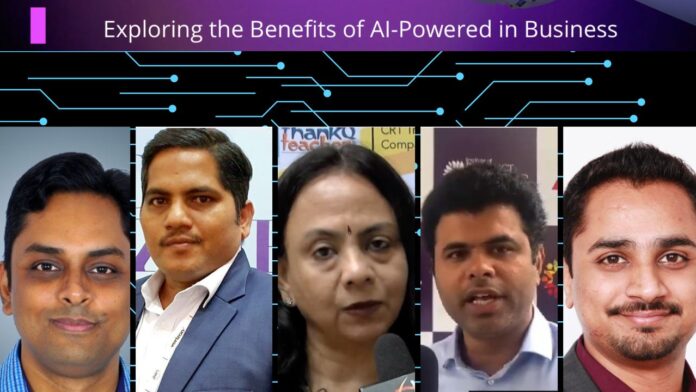At the recent Product Leaders Forum 2023, a distinguished panel convened to delve into the “Artificial Intelligence for the Real World” theme. Moderated by Sree Lata Shankar, an HR and L&T leader with a rich blend of experiences spanning sectors like banking, telecom, and IT, the discussion promised profound insights.
The panel boasted a diverse roster of experts:
Krishna Chaitanya Puttagunta, the fashion-tech visionary behind Zapero AI, is redefining the intersection of AI, creativity, and efficiency in the fashion landscape.
Dr. Venugopal Jarugumalli, DGM AI/ML, ZF Group, a seasoned analytics evangelist whose expertise bridges business quandaries with analytic resolutions.
Somasundar Konduri from ADP, an HR maestro, steering strategic HR initiatives that resonate on a global scale.
Amit Sharma, Senior Director, Ericsson, passionately weaving the threads of AI and ML into the telecom fabric.
Sree Lata Shankar, an HR and L&T leader, moderated the panel discussion
Below is an extract from the panel discussion presented in Q&A format. It offers the collective knowledge of these industry stalwarts, offering a panoramic view of AI’s evolving role across domains.
AI Applications in HR
Q1 Can you share a specific AI application that has made a considerable impact in your industry?
Somasundar Konduri: While the allure of the latest tech tempts many in the product management community, ensuring the technology serves real-world problems is crucial. At ADP, our primary strategy centres around improving user experiences. One significant example is our chat summarisation tool. This AI-driven system captures and summarises calls automatically so our client service reps can focus entirely on addressing the client’s needs rather than getting sidetracked by manual note-taking. This not only enhances efficiency but profoundly enriches the client experience.
AI Implementation Challenges in the Telecom Domain
Q2 What unique challenges does your industry encounter when implementing AI? And how are they being addressed?
Amit Sharma: In the last four years, I’ve been deeply involved in the telecom domain. While many are familiar with HR challenges, I’ll delve into the telecom sphere. A pressing concern today, especially with the rollout of 5G, is energy and sustainability. 5G devices, though efficient in delivering high bandwidths, consume significant power. The cell towers, which communicate with your devices constantly, drain a lot of energy. We’ve introduced “sleep modes” to manage this energy consumption better. However, activating or deactivating these modes based on traffic without compromising service quality is a complicated task AI is helping us solve.
To address the core of your question about challenges: One, the decision-making process here has to be rapid, often in microseconds. So, embedding AI solutions in such a fast-paced environment is tough. Two, the sheer volume of data in the 5G realm is vast. 5G employs high-frequency communication, which means its range is limited compared to 4G. Thus, we need more towers and devices to communicate and generate more data. Managing this data intelligently without overburdening the network is another challenge. We’re working on solutions to minimise data transfer for network management while maintaining energy efficiency and top-notch user service.
AI’s Potential vs Real-world Impact
Q3 Dr. Venugopal, can you highlight the differences between AI’s potential and its actual real-world impact?
Dr. Venugopal Jarugumalli: AI starts with data management, transitioning to insights generation and, eventually, automation. In product management, AI aids informed decision-making, with tools evolving through generative AI, optimising tasks. In real-world applications, like navigation apps, AI has revolutionised daily life. However, generative AI sometimes falls short of expectations. We’re developing the “AI Application Life Cycle Management,” aiming to predict future product developments based on past data. Another initiative, the “Computer Vision Toolbox,” seeks to predict product failures using image data. While AI’s potential is vast, bridging the gap to its complete real-world realisation remains a work in progress.
Vision and Real-world Impact of AI in Fashion
Q4 How do you ensure that your AI projects in the fashion industry result in tangible benefits?
Krishna Chaitanya Puttagunta: I’m the CEO of Zapero AI, where we use generative AI to enhance the creative processes of fashion designers. The challenge in the fashion industry is its heavy reliance on creativity, which traditionally takes more work to replicate with machines. However, we saw the potential of generative adversarial networks to revolutionise this domain. Our initial approach was to offer a SaaS product to streamline design creation. While AI-generated designs were welcomed, monetising them proved challenging. Our research showed that the fashion industry grapples with sustainability issues, with excess fabrics ending up in landfills. Recognising this, we focused on creating AI designs with a higher market success rate, combining creativity with a scientific approach to reduce waste and boost profitability.
AI Accessibility
Q5 How is Ericsson making AI understandable for non-experts?
Amit Sharma: Ericsson emphasises AI literacy, running workshops to broaden everyone’s grasp on AI’s capabilities. We have a two-pronged approach: research to explore AI’s potential and a global accelerator team to transform those insights into real-world solutions. Trustworthiness and explainability in AI are now mandates, especially with regulations like GDPR. We often favour simpler models to ensure transparency, even if it means a slight drop in accuracy. Proper expectation setting is vital; AI’s results are probabilistic and imperfect. For instance, our predictive maintenance might promise long-term cost reductions rather than immediate perfection. And importantly, user interfaces should be clear and uncomplicated, offering users just the necessary information.
AI in HR
Q6 How is AI utilised in ADP for human capital management and its effect on employee growth?
Somasundar Konduri: AI’s introduction in large entities, like ADP, is in its learning phase. Our immediate challenge is data governance and adhering to data privacy laws. Ensuring confidentiality is foundational. We’re educating employees about AI’s benefits for enhancing product and client experiences while emphasising measured and thoughtful approaches. Creating a safe environment for experimentation without compromising data privacy is crucial. We encourage open dialogues about AI, allowing ideas to surface. The focus is to address problems systematically, instilling this mindset in our staff. Our strategy, rooted in transparency, seeks to empower and inform. A notable AI application has been in optimising call case notes, substantially enhancing productivity. Instead of manually noting, AI summaries save significant time without job redundancy. Feedback from associates indicates positive shifts in their work experience due to such advancements.
AI in Fashion
Q7 Could you provide an example of a product or initiative?
Krishna Chaitanya Puttagunta: We focus on “creative AI” for design. Like Gen Z, young generations are gravitating towards influencer-driven brands on platforms like TikTok. Surprisingly, TikTok commerce in Indonesia hit $3 billion within three months this year. The market is diversifying from a few major brands to myriad smaller ones. Our goal is to support this emerging “creator economy” by offering tools tailored for them. Soon, consumers might design directly, using platforms like ours to express unique requirements, with AI suggesting designs. We aim to empower individuals to be creators for themselves, amplifying, not replacing, human creativity.
AI Integration Evolution
Q8. Venugopal, how are you preparing for future AI trends?
Dr. Venugopal Jarugumalli: We’re transitioning to a data-driven model and addressing challenges in integrating software engineering into AI. Prompt engineering is an emerging trend. We’re emphasising the development of AI engineers and promoting citizen developers and data scientists for a more inclusive AI approach. While open AI frameworks offer potential, we’re cautious due to cybersecurity concerns. Composite AI, which merges multiple data sources, is gaining traction. For instance, warranties now integrate claims data with visuals. Our company, spanning from manufacturing to software, requires a seamless integration of various technologies. Coaching and training initiatives are in place to build citizen data scientists. As AI evolves, it’s vital to prioritise trust, value, and multifaceted analyses. Preparing our team for digital transformation and ensuring effective change management remains a top priority.
AI Augments Humans
Q9. How can we integrate AI into HR while ensuring human skills are still essential for value creation and AI complements rather than replaces human abilities?
Somasundar Konduri: One example is our new product, a conversational user interface that can be rapidly deployed and starts learning immediately. It doesn’t just provide surface-level information but delves deeper into the nuances of inquiries. However, like a child, this tool needs human input for training and iteration. Humans provide the guardrails and the necessary feedback. AI won’t replace humans; instead, it allows us to focus on strategic, creative tasks over operational ones. Many years ago, I was filing documents manually; today, it’s digital, but that didn’t remove my job. Instead, it made it more nuanced. In recruitment, AI helps sift through profiles, aiding talent acquisition by identifying the best resumes from a vast pool. This enhances efficiency in the hiring process.
AI Misinformation Threat
Q10. Krishna Chaitanya, can you discuss a potential risk or challenge you’ve seen in AI and how you addressed it?
Krishna Chaitanya Puttagunta: While some envision catastrophic risks like weaponised AI, the immediate concerns lie in misinformation. With advanced AI, it’s now feasible to fabricate content or images depicting events that never occurred. For instance, AI-generated images on platforms like Twitter could provoke societal discord. The real risk lies in AI’s ability to produce content nearly indistinguishable from human-generated content. Today, an expert can differentiate content created by machines from that made by humans. However, if we persist on this trajectory, distinguishing between the two might become nearly impossible in a few years, leading to significant societal challenges. This misinformation risk is profound and pressing.
Accountability, Innovation, Security
Q11. How does your organisation maintain transparency?
Dr. Venugopal Jarugumalli: Accountability is at the core of our operations. We promote innovation and offer equal opportunities, emphasising the democratisation of processes. Alongside this, we rigorously address cybersecurity concerns. Our communication team directs and facilitates our communications, ensuring everyone is informed without any data breaches. Surprisingly, we restrict the use of platforms like Google for messaging, emphasising our focus on internal innovation. We are deeply involved in the future of mobility, working on projects like connected and driverless cars. Our strength lies in our generative approach, where we create our own systems and designs, ensuring everything is developed in-house.
Continual Learning, Grounded Innovation
Q12 Amit, in the AI era, what do you see as essential skills for future product leaders?
Amit Sharma: Continual learning is paramount, given the rapid pace of change. However, it’s crucial to remain grounded and not get overly enthused. It’s about harnessing the potential of tools like AI rather than forcing its application, as that can lead to misguided efforts and potential failures. As AI disrupts even creative roles, product leaders need to maintain their innovative spirit. Despite AI advancements, foundational product management principles remain unchanged: understanding the user, identifying the right problems, and devising solutions. With these basics, we’re poised to produce successful products.
Q13. If a system could flawlessly execute one task for you in your personal life, what would it be and why?
Amit Sharma: I’d want it to organise my messy room or help me comprehend my wife’s words better, a common challenge among husbands.
Krishna Chaitanya Puttagunta: I’d hope for AI to take over driving, especially on highways, as I detest it. For entrepreneurs, while technology is vital for products, a successful business requires more than just a functional product.
Dr. Venugopal Jarugumalli: I’d prefer an AI bot that efficiently manages my finances without overwhelming me with excessive notifications.
Somasundar Konduri: I’d leverage AI to strike a balance between logic and emotions, stemming from my computer science background and HR role.




